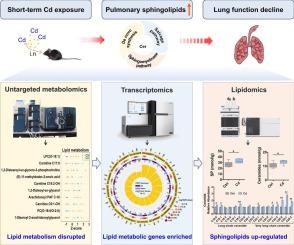短期呼吸性镉暴露导致小鼠肺功能下降,并伴有鞘脂合成上调
IF 9.7
1区 环境科学与生态学
Q1 ENVIRONMENTAL SCIENCES
引用次数: 0
摘要
镉(Cd)是一种呼吸道毒物。以前的报告已经证实,慢性呼吸性Cd暴露在小鼠模型中引起慢性阻塞性肺病样病变。本研究旨在评估短期Cd暴露对肺功能的影响。成年C57BL/6J小鼠通过吸入不同浓度的氯化镉气溶胶(25 mg/L或100 mg/L,每天2 h),连续5 天暴露于镉。采用ICP-MS测定血清Cd含量。观察肺组织病理学和肺功能。实时RT-PCR检测肺部炎症因子。利用非靶向代谢组学、转录组测序和靶向脂质组学来探索其机制。Cd暴露小鼠血清Cd水平轻度升高,肺泡结构轻度损伤。在cd暴露的小鼠肺中观察到明显的肺功能下降,并伴有炎症细胞因子上调。非靶向代谢组学和转录组学显示,cd暴露小鼠的肺脂质代谢被破坏。脂质组学证实,神经酰胺和鞘脂在cd暴露的小鼠肺中显著增加。肺SPTLC1是神经酰胺从头合成限速酶的重要亚基,神经酰胺合成酶,如CerS2和CerS6,在cd暴露的小鼠中升高。本研究结果提供了短期环境暴露可能通过上调肺鞘脂合成引起肺功能下降的实验数据。本文章由计算机程序翻译,如有差异,请以英文原文为准。


Short-term respiratory cadmium exposure causes pulmonary function decline accompanied by upregulation of sphingolipid synthesis in mouse lungs
Cadmium (Cd) is a respiratory toxicant. Previous reports have confirmed that chronic respiratory Cd exposure causes chronic obstructive pulmonary disease-like lesions in a murine model. This study aimed to evaluate the influence of short-term Cd exposure on lung function. Adult C57BL/6J mice were exposed to Cd through inhaling different concentrations of cadmium chloride aerosols (25 mg/L or 100 mg/L, 2 h per day) for 5 days. Serum Cd was quantified by ICP-MS. Lung histopathology and lung function were evaluated. Pulmonary inflammatory cytokines were measured by real-time RT-PCR. Untargeted metabolomics, transcriptome sequencing, and targeted lipidomics were used to explore the mechanism. Serum Cd level was slightly elevated and alveolar structure was mildly damaged in Cd-exposed mice. An obvious lung function decline was observed, accompanied by upregulation of inflammatory cytokines in Cd-exposed mouse lungs. Untargeted metabolomics and transcriptomics showed that pulmonary lipid metabolism was disrupted in Cd-exposed mice. Lipidomics confirmed that sphingolipids, including ceramides and sphingosine, were significantly increased in Cd-exposed mouse lungs. Pulmonary SPTLC1, an essential subunit of the rate-limiting enzyme for ceramide de novo synthesis, and ceramide synthases, such as CerS2 and CerS6, were elevated in Cd-exposed mice. The present results provide experimental data that short-term environmental exposure causes pulmonary function decline probably by upregulating pulmonary sphingolipid synthesis.
求助全文
通过发布文献求助,成功后即可免费获取论文全文。
去求助
来源期刊

Environment International
环境科学-环境科学
CiteScore
21.90
自引率
3.40%
发文量
734
审稿时长
2.8 months
期刊介绍:
Environmental Health publishes manuscripts focusing on critical aspects of environmental and occupational medicine, including studies in toxicology and epidemiology, to illuminate the human health implications of exposure to environmental hazards. The journal adopts an open-access model and practices open peer review.
It caters to scientists and practitioners across all environmental science domains, directly or indirectly impacting human health and well-being. With a commitment to enhancing the prevention of environmentally-related health risks, Environmental Health serves as a public health journal for the community and scientists engaged in matters of public health significance concerning the environment.
 求助内容:
求助内容: 应助结果提醒方式:
应助结果提醒方式:


